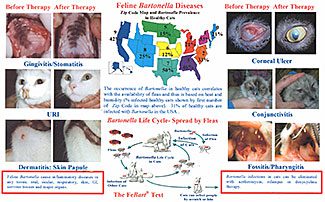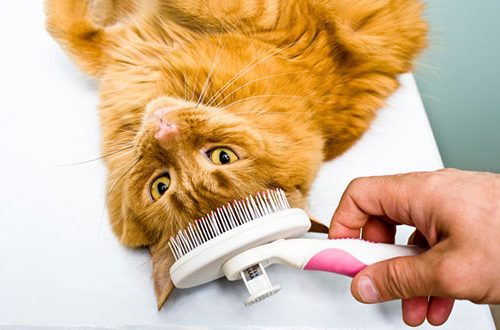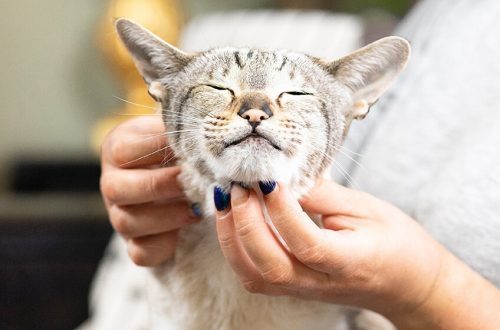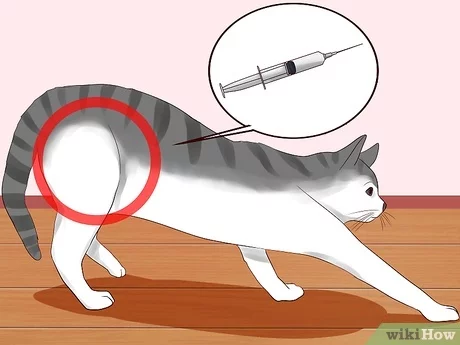
How to independently make an intramuscular and subcutaneous injection for a cat
Contents
In what places can you put an injection
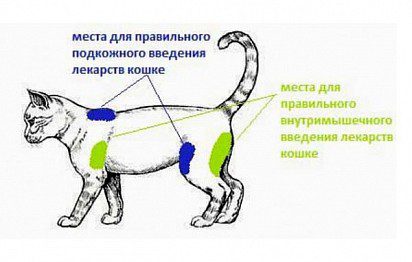
Both people and animals are injected under the skin, into a vein, muscle, joint, intra-abdominal space. Intravenous, intra-articular, intra-abdominal injections can only be done by a specialist (in extreme circumstances, you can see how it is done in a clinic, ask about the features of the technique and try it yourself under the supervision of a doctor). And to master the technique of injecting the drug intramuscularly and subcutaneously is within the power of any owner.
An injection should be given to a cat only in areas whose anatomical features make it possible to achieve the greatest therapeutic effect. For intramuscular injections: the back of the muscles of the shoulder and thigh, subcutaneous – a fold between the shoulder blades at the withers, a fold between the body and the front of the thigh. Which way to choose where to inject the medicine depends on the chosen remedy.
How to choose the right syringe
The syringe is also selected depending on the drug – its volume and injection site. For an injection into the muscle, instruments with a volume of 1-10 ml are suitable. If the amount of medicine is large enough, a syringe should be purchased for smooth administration, in which the piston is equipped with a special seal. With a small volume of injection solution (up to 1 ml), an insulin syringe with a convenient graduation is used.
It is desirable that the needle with which the drug is administered intramuscularly is not too long. The thigh and shoulder muscle of a cat (especially kittens) is small, which increases the risk of damage to the sciatic nerve or bone. Here, too, an insulin syringe equipped with a thin and short needle will help out. An injection into muscle tissue is more painful than under the skin, and a thin, sharp needle will slightly reduce pain.
Subcutaneous injections are more easily tolerated by animals – there are not too many nerve receptors at the withers. Needles can be taken longer and thicker, and syringes of different sizes, depending on the indications. Typically, the amount of drug injected into the subcutaneous space is greater than into the muscle.
When selecting a tool for injections in a cat, the consistency of the drug is taken into account. Oil solutions are viscous, ductile and require larger diameter needles.
Preparing for an injection
Before giving an injection to a cat, you need to prepare everything you need.
- Decide where the procedure will take place. It should be smooth, not slippery, preferably at the level of a regular table.
- Before taking the medicine, you should make sure that the drug is not expired. It will not be superfluous to re-read the instructions for the medicine, as well as the veterinarian’s appointment for time and dosage.
- The cold preparation must be heated to body temperature (it is enough to hold it in your hand for some time).
- To collect the medicine from the ampoule, its upper narrow part is broken, having previously wrapped it with a piece of cotton wool.
- The powder form of the product must be diluted with saline, novocaine or a special solution that comes with the kit (for details on dosage, check with your veterinarian). First, a solution is drawn into the syringe, then it is injected into a vial of powder, the medicine is dissolved with light circular movements (without shaking), and it is drawn back into the syringe. After that, it is desirable to change the needle.
- When the medicine is taken, you should get rid of air bubbles – raise the syringe with the needle up, do not knock hard on the cylinder, making sure that the bubbles accumulate under the medicine exit hole, press the piston a little until air comes out and drops of the drug appear.
Unnecessary cotton wool, ampoules and other items should be disposed of, and the prepared syringe can be briefly put on a clean surface (plate, container), closing the needle with a cap.
The rate of drug administration
The speed with which you need to give an injection to a cat depends on the place of injection of the drug. With intramuscular injection, a large amount of solution is administered longer: if the volume is about half a cube, a second is enough, and for one milliliter it will take 2-3 seconds. If the cat is given an injection under the skin, the speed does not really matter.
How to inject into the thigh
An intramuscular injection to a cat is made into the thickness of the femoral or brachial muscle. Before making an injection, it is necessary to feel the muscle, determine the injection site, make sure that the animal is calm and the muscle tissue is relaxed. For relaxation, you can pre-massage the limb.
The angle of insertion of the needle into the thigh should be approximately 90˚, the penetration depth should not exceed a centimeter. It is necessary to ensure that the needle does not completely enter the muscle – there should be a gap between the surface of the body and the plastic.
As soon as the needle is in the muscle tissue, you need to calmly press the plunger and slowly inject the medicine. It is impossible to move, turn, deepen the syringe during the injection. Remove it in the opposite direction, with a quick movement.
How to make a hypodermic injection
Injecting a cat under the skin is easier than in the thigh. Firstly, the withers are considered less sensitive to mechanical influences (it’s not for nothing that cats drag their cubs by the withers), so this place is ideal for the introduction of painful solutions. Secondly, much larger volumes of medicinal solutions (up to 70-90 ml) can be injected subcutaneously than into the femoral part. Thirdly, there is no risk of the needle getting into the bone, joint or nerve, as is the case with intramuscular injection. The only point that needs special attention is that the skin here is thicker than the femoral part, so you need to make an effort to pierce it.
The injection technique under the skin is as follows:
- with one hand in the area of uXNUMXbuXNUMXbthe withers, the skin must be folded;
- with the other hand, under the skin pulled upwards, closer to the body, with some effort, insert the needle at an angle of 45˚ relative to the surface of the body;
- administer a drug;
- remove the syringe;
- let go of the skin.
It is advisable that someone from the side during the procedure slightly press down the head and back of the pet’s spine.
Important! In the absence of experience with subcutaneous administration of drugs to a cat, there is a risk of piercing the skin through. This probability is due precisely to the thickness of the skin and its resistance during piercing with a needle. Therefore, during the injection process, you need to pay attention to the opposite side of the fold – if droplets appear on it, the needle should be pulled slightly towards you, and then continue the procedure.
What complications can be
The introduction of medicinal solutions, regardless of the place, injures the surrounding tissues. Complications can arise not only with the inept procedure, but also with an experienced specialist. The most common side effects of injections are:
- hematomas – are formed due to damage to the blood vessel with a needle and the penetration of blood into neighboring tissues, do not require special treatment, pass by themselves;
- blood protruding after removing the needle – just as in the previous case, it is a sign of damage to the blood vessel; to stop the bleeding, it will be enough to apply cold to the wound;
- lump, induration, swelling at the injection site – may have several reasons, for example: too rapid administration of the drug, infection penetration into the wound, individual tissue reaction, and others, if the lump does not go away for a long time, and the cat’s health worsens, you need to show the pet to a specialist;
- lameness – may be a consequence of the injection itself, as damage to soft tissues, for example, with severe soreness of the solution, or the result of a needle entering the sciatic nerve; in the latter case (if the damage persists for more than 2-3 days, and the paw remains motionless), you need to visit a veterinarian;
- deviations in behavior – a normal reaction of the animal, passing independently over time; the cat may panic, avoid touching, flinch, and so on;
- an increase in body temperature – more often occurs as a reaction to the injected solution, a manifestation of an allergy, and also if sterility was not observed during the procedure, and an infection got into the wound.
Additional symptoms that you need to pay attention to and see a doctor: pus from the skin puncture site, painful lumps, refusal to eat, loss of activity, apathy for more than 3 days after the injection.
helpful hints
In order to independently inject a cat and avoid complications, you must adhere to the following recommendations:
- for injections, only a sterile syringe should be used, which must be disposed of after the procedure;
- the needle must not be touched by hand, otherwise it must be replaced;
- before carrying out the procedure, it is better to fix the pet in a stationary state, leaving only the injection site open (you can use a harness, blanket, sheet and other auxiliary items) or invite someone from the side to hold the cat;
- as a rule, injections are made into an intact area of uXNUMXbuXNUMXbthe skin, so if the animal has any skin disease, you must first clarify this issue with a veterinarian;
- it is not necessary to disinfect the injection site, but the owner must first wash his hands with soap and treat with an antiseptic;
- if the doctor has prescribed injections every day or several times a day, it is best to give injections to the paw alternately – to the right and left or front and back, in order to avoid severe trauma to the cat’s tissues and allow them to heal;
- oil-based medicine should not be allowed to enter the bloodstream; you can make sure that the needle does not enter the blood vessel by slightly pulling the piston towards you after inserting the syringe – the absence of blood in the solution indicates that the vessels are not affected, and you can continue the procedure;
- it is impossible to inject more than one drug at the same time in one syringe, unless it is allowed by a specialist.
To support a mustachioed pet during the procedure, as well as before and after it, you need to talk to him as affectionately as possible, stroke, calm down. At the end of the manipulations, you should give the cat something tasty.
Each owner can independently give an injection to a cat, the main thing is desire. Well, if the skill is not useful, but mastering it will not be superfluous at all.



